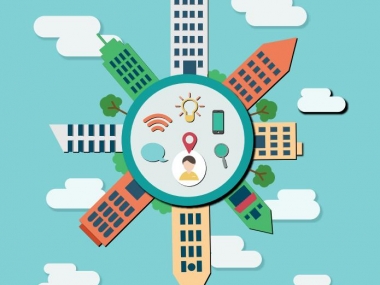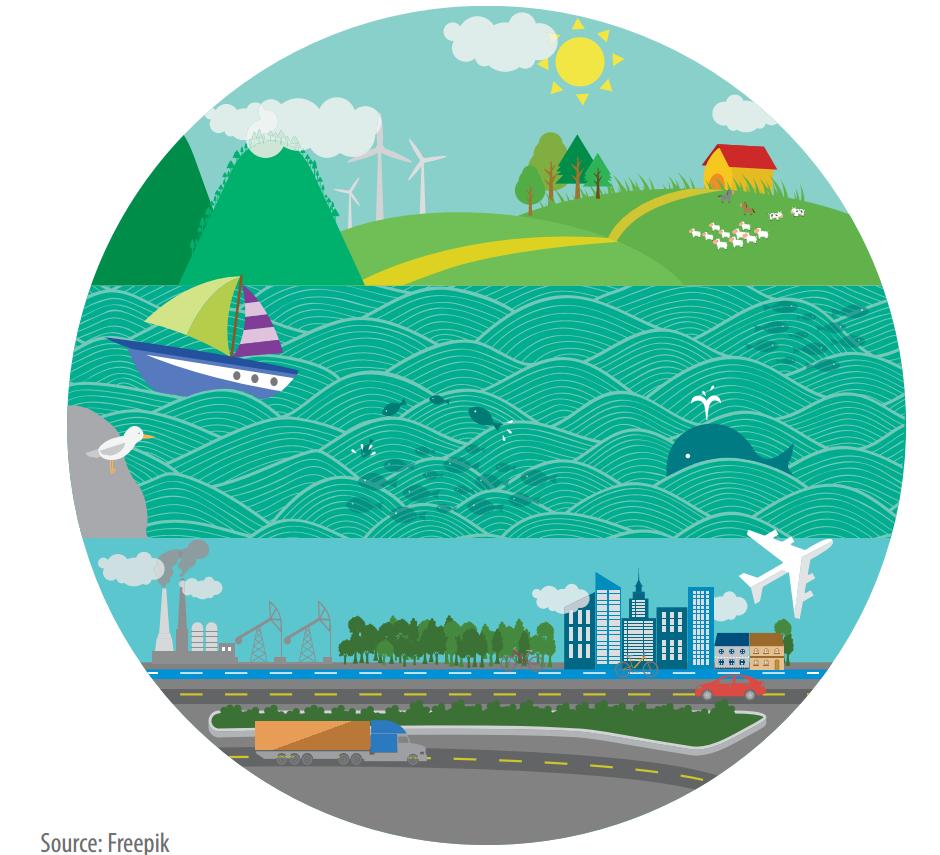Why ‘Think Global, Act Local’ is no longer enough
Edited on
24 June 2019How can cities refresh the message ‘think global, act local’ and build common purpose amongst stakeholders – citizens, communities, elected representatives, businesses, civil servants – to achieve the impacts that are needed in towns and cities across Europe and across the world?

This is an excerpt of the article featured in the URBACT Capitalisation 'Sustainable regeneration in urban areas.' To read the full article click here.
In the 20 years since the Rio Earth Summit from which it emerged, the evidence for climate change has become ever more robust and the case for action ever more urgent. Whilst the rate of resource consumption has increased exponentially, there is increasingly limited capacity for continued emissions and other environmental impacts before tipping points are reached, beyond which there is a high risk of catastrophic consequences. With mounting evidence of escalating environmental damage, it is essential that cities deepen their understanding of these environmental limits at all levels and devise better ways of accounting for pressures and impacts that are taking them up to and beyond these limits.
Cities need to use this knowledge to inform the actions in neighbourhoods, cities and regions, as well as nationally and globally. Critically, climate change is only one of numerous environmental limits identified in the latest research, in addition to biodiversity loss and land-use change for example. It’s clear that the ‘think global, act local’ message does not quite capture the gravity of the situation cities now face; it is commonly used to support localised and incremental improvements on current practice in environmental sustainability, rather than unlocking the systemic change required at neighbourhood, city, regional and national level to meet the scale of the challenge as it is now understood. Below we introduce the latest thinking on environmental limits, and then consider what this might mean for European urban regeneration in the coming years.
Over the past decade, a number of scientific approaches to the calibration of environmental limits have emerged. Foremost amongst these is the Stockholm Resilience Centre’s ‘Planetary Boundaries’ concept, which identifies nine planetary processes where boundaries, if transgressed, could have destructive or catastrophic consequences. Planetary boundaries delineating a ‘safe operating space for humanity’ are at an early stage of development and process boundaries for cities are yet to be established, but it is clear that these processes are driven by urban patterns of resource use globally and require action at a neighbourhood and city level if our urban lifestyles are to be sustainable.
"Global Ecological Fooprint estimates expressed in terms of numbers of planets"**

Steffen et al., 2015
The science of ‘Footprinting’ provides another way of considering the relationship between resource use and environmental limits. It works by adding up the annual consumption of key natural resources by individuals, organisations and nations across the world. Footprinting is used to measure different types of resource use, most commonly carbon but also water, land, etc. Ecological Footprinting, developed by the Global Footprint Network (GFN), goes one step further and brings together a whole range of different resource footprints and measures them against the estimated quantity of each resource available on the planet. The main conclusion from this work is that if everyone in the world were to live like an average European, we would need three planets to live on. Cities like London have used footprinting to think through their transition to more sustainable consumption and production (for more details see the publication here).
Other scientific approaches explore the issue in different ways again, for example Natural Capital Accounting enables environmental limits to be considered in a financial and economic context. While each of these approaches can be used to frame powerful and compelling messages about environmental limits and how people can respond to them, they are all conceptually complex and are still developing. They are each contested in different ways, and are only partially integrated into global policy initiatives by the Intergovernmental Panel on Climate Change (IPCC) and the United Nations (UN) – particularly on carbon, biodiversity loss, and ozone for example. Yet, there is a consistent overarching message emerging which tells us that it’s simply not sufficient to act locally and think globally. We rely on global resources and services in our local daily lives, and the stresses and impacts of our local consumption are felt disproportionately around the world. We must measure our progress in sustainability not against ‘business as usual’ but against the environmental limits of the planet, because whichever way we measure it we are on a trajectory to dramatically overshoot them. Many of us are living as if there were three planets’ worth of resources, and we need a paradigm shift that recognises there is only one planet’s resources available.
So, what does this mean for urban regeneration in Europe?

It’s clear we need to redouble our efforts and raise the ambition and impact of our environmental interventions to a level commensurate with the reality of the challenge. Some of these issues may initially appear somewhat abstract and remote from the usual scope of urban regeneration interventions. However, we should not expect environmental interventions in 2015 to be the same as they were in 1992 when the first Earth Summit took place in Rio, and the direction of travel is likely to focus increasingly on a more ‘restorative’ approach. This will involve going beyond making more efficient use of resources to actually reducing our overall consumption of resources dramatically. It will involve going beyond adaptation to the impacts of climate change and environmental degradation and build social and economic resilience to the consequent upheavals that we now know are imminent. And it will need to go beyond the conservation of natural habitats, and culturally reconnect people to natural systems, including food, water, ecology and other geographical systems. The degree of transformation required in urban lifestyles will likely not be achievable without these ‘restorative’ social, economic and cultural dimensions which can give value to this new way of living, particularly through improvements in health, well-being, and social and economic inclusion.
More specifically, in terms of energy use, we will increasingly move beyond Zero Carbon standard to Carbon Positive – locking in embodied carbon for example through use of timber construction and exporting energy to the grid, absorbing carbon emissions to compensate for where it is more difficult to make reductions. In terms of transport, providing sustainable and public transport alternatives on their own will not be enough; we will need to enable truly car-free lifestyles through higher-density neighbourhoods, co-working opportunities, smarter use of information technologies and patterns of mixed land use which can help reduce the need to travel. In terms of adaptation to climate change, technical and infrastructural solutions in water management and heat island effects will need to be integrated with wider socio-economic measures to reduce vulnerability of key groups – the elderly and low-income households in particular – and build their resilience.
 In terms of biodiversity and open space, we will need to move beyond conserving habitats of individual species to enhancing whole urban ecosystems to provide healthy places to live for networks of flora and fauna; this can support health and leisure of urban populations, and enable city dwellers to reconnect and experience nature and wildlife in their daily lives. In terms of resource use, not only do we need to achieve Zero Waste, but we also need to source more of our materials sustainably and where possible locally; this will mean changes to our consumer choices and production relationships along supply chains, which ideally will become more localised and regionalised. In terms of food systems, we need to reconnect people with an understanding and direct experience of food growing and food systems, explore opportunities for low-impact and Zero Carbon food, and develop food cultures based on a more balanced plant-based diet. In terms of measuring impact, we will be moving beyond monitoring of technical data streams to monitoring a fuller range of outcomes including health, well-being, social inclusion and environmental quality. And so on…
In terms of biodiversity and open space, we will need to move beyond conserving habitats of individual species to enhancing whole urban ecosystems to provide healthy places to live for networks of flora and fauna; this can support health and leisure of urban populations, and enable city dwellers to reconnect and experience nature and wildlife in their daily lives. In terms of resource use, not only do we need to achieve Zero Waste, but we also need to source more of our materials sustainably and where possible locally; this will mean changes to our consumer choices and production relationships along supply chains, which ideally will become more localised and regionalised. In terms of food systems, we need to reconnect people with an understanding and direct experience of food growing and food systems, explore opportunities for low-impact and Zero Carbon food, and develop food cultures based on a more balanced plant-based diet. In terms of measuring impact, we will be moving beyond monitoring of technical data streams to monitoring a fuller range of outcomes including health, well-being, social inclusion and environmental quality. And so on…
With Europe the most urbanised continent on the planet, the environmental decisions we make in cities over the coming years will be crucial to meeting the global sustainability challenge. If we can integrate concepts of environmental limits into urban programmes we have a chance of safeguarding the environment for future generations, and setting a benchmark for other urbanised nations to emulate. The benefits for cities include increased resilience to the impacts of climate change, but also a better quality of life for residents – healthier and more active urban lifestyles, more localised urban economies with new economic opportunities and more inclusive urban societies in terms of age, income, mobility, etc. Because these potential benefits will be more tangible than the risks associated with climate change and other environmental limits, it will be important to use them to communicate with residents and stakeholders. However, while continuing to ‘think globally and act locally’ we do need to raise our game. It’s time for a new catchphrase for sustainable development that can communicate the true urgency of the challenge: to borrow from Bill Clinton’s campaign slogan, “it’s the planet, stupid!”.
Written by Connor Moloney
Photo Credit: Freepik
**Currently it is estimated that all of humanity is consuming approximately 1.5 planet’s worth of annual resources, however this masks wide variations in resource consumption between high-income countries (3 planets and higher) and low income countries (0.5 planets and lower), and of course also between high-income and low-income households (Global FootprintNetwork).
 Submitted by CMoloney on
Submitted by CMoloney on




